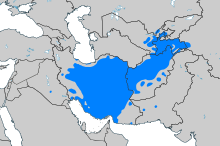
Back Аџьам бызшәа Abkhazian Bahsa Parisi ACE Персыбзэ ADY Persies Afrikaans Persische Sprache ALS ፋርስኛ Amharic Idioma persa AN Persisc sprǣc ANG फारसी भाषा ANP اللغة الفارسية Arabic
| Persian | |
|---|---|
| Farsi | |
| فارسی | |
 Farsi in Persian script (Nastaʿlīq style) | |
| Pronunciation | [fɒːɾˈsiː] |
| Native to | Iran[1] Afghanistan[1](as Dari) |
Native speakers | 60 million (2009)[2] (110 million total speakers)[2] |
Early forms | |
| Dialects | |
| Arabic (Persian alphabet) Cyrillic (Tajik alphabet) Hebrew script Persian Braille | |
| Official status | |
Official language in | |
Recognised minority language in | |
| Regulated by | Academy of Persian Language and Literature (Iran) Academy of Sciences of Afghanistan |
| Language codes | |
| ISO 639-1 | fa |
| ISO 639-2 | per (B) fas (T) |
| ISO 639-3 | fas – inclusive codeIndividual codes: pes – Western Persianprs – Eastern Persiantgk – Tajikiaiq – Aimaqbhh – Bukharichaz – Hazaragijpr – Dzhidiphv – Pahlavanideh – Dehwarijdt – Juhurittt – Caucasian Tat |
| Linguasphere | 58-AAC (Wider Persian) > 58-AAC-c (Central Persian) |
 Approximate extent of the Persian language area. Map includes all three dialects of Persian. | |
Persian, also called Farsi, is a Western Iranian language. It is the official language of Iran, Afghanistan and Tajikistan. It is also spoken by many people in Pakistan, Uzbekistan, Azerbaijan and other neighbouring countries and by immigrants from Central Asia in Russia. Persian was also taught as a second language in schools in Pakistan until 2006. In the past, many of those places were parts of the Persian Empire.
Persian has many dialects and is officially called Farsi in Iran, Dari and Farsi in Afghanistan and Tajiki in Tajikistan. The literary language of each country is a little different, but people from each country can understand one another when they have a conversation. It has words from French in Iran and many from Russian Tajikistan.
- ↑ 1.0 1.1 1.2 1.3 Samadi, Habibeh; Nick Perkins (2012). Martin Ball, David Crystal, Paul Fletcher (ed.). Assessing Grammar: The Languages of Lars. Multilingual Matters. p. 169. ISBN 978-1-84769-637-3.
{{cite book}}: CS1 maint: multiple names: editors list (link) - ↑ 2.0 2.1 2.2 2.3 2.4 2.5 Windfuhr, Gernot. The Iranian Languages. Routledge. 2009. p. 418.